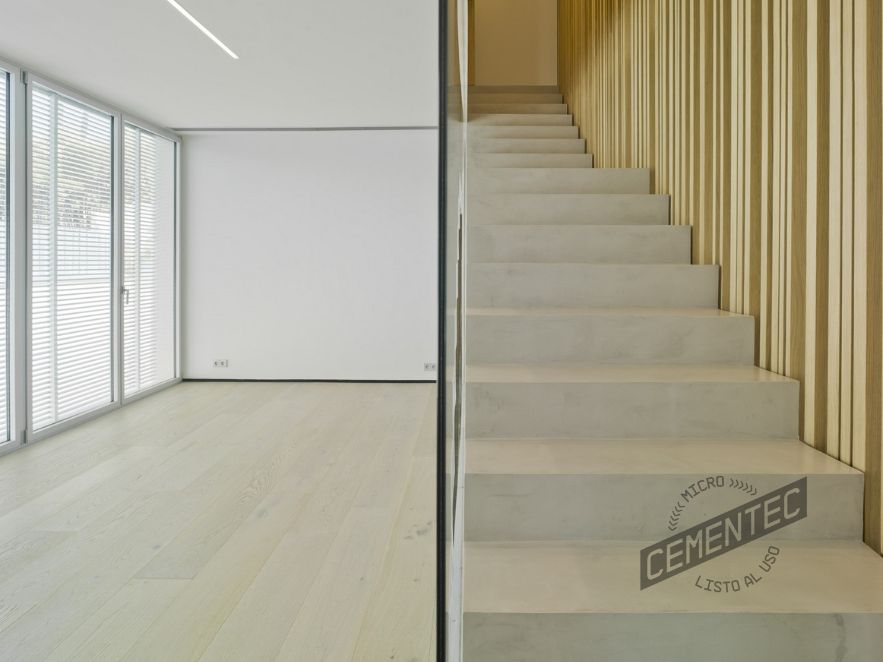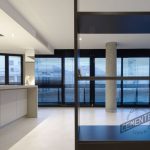Stairs are a focal point in any multi-story home, and their design and finish can dictate the aesthetic of the surrounding space. When you are considering different options for renovations, many people are discovering microcement and wood stairs as an aesthetic and functional solution. This combination is not only visually striking, but also practical. However, it is natural that doubts arise when undertaking this essential reform project.
You have probably already considered ready-to-use microcement as a valid option given its popularity and approval by interior designers and designers, but what happens when you fuse it with wood? Paraphrasing the previous article in which we talked about microcement and natural wood, this combination results in a visual harmony and a tactile warmth that is difficult to beat.
Therefore, if you are looking for inspiration and answers about how to take maximum advantage to your home staircase, you are in the right place. Cementec is proud of being leaders in the Ready-to-use microcement application, helping a large number of clients to shake up their interior areas, particularly stairs, with this unbeatable duo.
We are going to guide you, throughout this article, via the multiples advantages, styles and possibilities which microcement and wooden stairs offer to guarantee that the renovation process meets your requirements.
Let your renovation project begin!
Why microcement and wooden stairs?
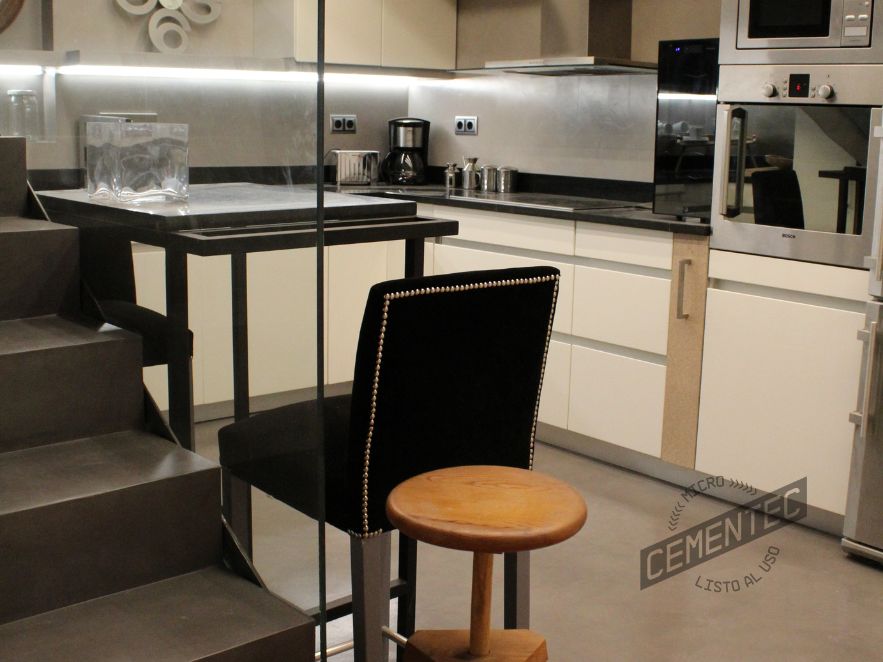
So, when you are faced with the decision of choosing materials for your staircase, you are not only selecting for aesthetics, but also for durability and functionality. And here, the microcement and wood duo stands out above many other options.
Let’s see below some of the advantages of microcement and wood stairs:
- Modern style and warmth: while the microcement provides an aesthetic and modern appearance, the wood introduces that warm and organic touch, resulting in a balanced design that captivates and adapts to various environments.
- Guaranteed Longevity: the combination of the robustness of microcement and the inherent durability of wood ensures a staircase that is not only aesthetically attractive, but also built to last.
- Creative flexibility: whether you opt for wooden steps combined with microcement elements or look for bolder interspersions, the versatility of these materials offers you a wide range of design possibilities.
If you want to delve deeper into the benefits and types of stairs on which this combination can be applied, we recommend that you review our detailed guide: Microcement stairs: Application method, tips and incompatibilities.
Which is the best wood material to be used on the steps of your stairs combined with microcement?
Indeed, as we point out in the guide that we have mentioned just above, wood is more than a simple material: it is an organic and dynamic entity that, depending on environmental factors such as temperature and humidity, has the capacity to expand and contract.
While these inherent properties give wood its character and natural charm, they can also present challenges when combined with other materials. A clear example is the joint use of wood and microcement. Variations in the wood can lead to the appearance of microcracks and incidents in the microcement, affecting not only its aesthetic appearance but also its integrity and longevity.
However, in the vast universe of wood types, there is a contender that stands out for its compatibility with microcement: DM wood, which translates to Medium Density Fibreboard.
This wood has been ingeniously designed to offer a more uniform and stable structure. Minimizing the typical variations of traditional wood and becoming the preferred choice for those who wish to combine the warmth of wood with the modernity of microcement.
Why DM wood is ideal for microcement and wooden stairs?
Immediately, we will delve into the essential characteristics of DM wood and understand why it has become the perfect ally for ready-to-use microcement applicators who seek versatility, durability and aesthetics in their projects.
- Dimensional stability: the DM stands out for its robustness against dimensional changes. Unlike traditional woods, this board has an exceptional ability to maintain its shape and size, significantly reducing its propensity to shrink or expand. This constant behaviour makes it the ideal companion for microcement, minimizing possible cracks or alterations in the coating.
- Homogeneous surface: the nature of DM gives it a uniformly smooth surface free of the typical imperfections or knots present in natural woods. This uniformity is essential to ensure that the microcement adheres optimally, resulting in a neat, high-quality finish.
- Adaptability and manageability: the versatility of the DM is undeniable. Its ease of being cut, polished and shaped makes it a highly adaptable material, allowing the creation of custom-made steps that fit perfectly with the specifications and desired design for your staircase.
Therefore, if you are considering coating your stairs with microcement and you have wooden steps, make sure they are made of DM. Not only will you guarantee the longevity and beauty of the finish, but you will also benefit from the multiple advantages that this wood and this product, microcement, offer.
DM wood and microcement style stairs
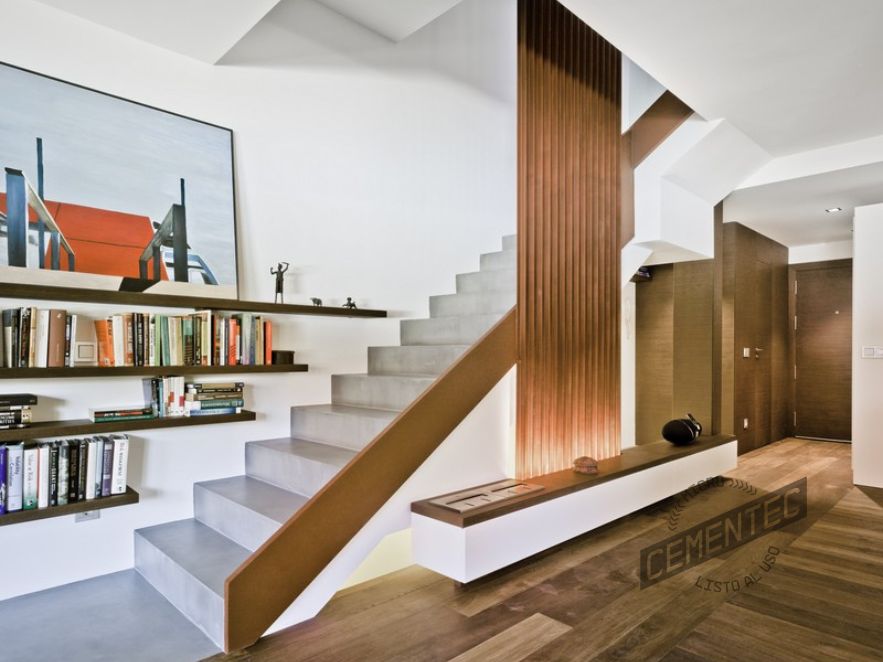
Accordingly, the marriage between microcement and DM wood has opened a range of stylistic possibilities that provide not only functionality, but also a contemporary and elegant aesthetic to spaces. Below are some of the most popular styles of stairs that combine these two materials:
- Minimalist: here, microcement covers most of the staircase, while DM wood details, such as the railings or the edges of the steps, add a touch of warmth.
- Modern rustic: although microcement is essentially contemporary, when combining it with DM wood with finishes that imitate natural textures. A balance is achieved between modern and traditional, creating a cozy atmosphere.
- Industrial: stairs in this design could have a microcement base with DM steps or railings, often accompanied by metal details.
- Floating: floating stairs give the impression that the steps are suspended in the air. In this design, the DM wood steps can be anchored to the wall and partially or completely covered with microcement, giving a striking visual effect.
- Scandinavian: microcement stairs with subtle touches of DM wood are complemented by neutral colour palettes and simple details.
- Two-tone: playing with the colours of microcement and DM wood can result in unique designs. Steps with contrasting halves or alternating colours are some of the options.
Whatever the architectural style or decoration of your home, you are likely to find an option that perfectly suits your needs and aesthetic tastes. These styles demonstrate the versatility and adaptability of the combination between microcement and DM wood.
Microcement and wood beyond the stairs
The charm of mixing microcement and wood is not limited only to stairs. This powerful combination of materials has conquered multiple spaces in the home. The contrast between the robustness of microcement and the natural warmth of wood creates a balanced and harmonious environment, ideal for any room.
- Sophisticated bathrooms: imagine a bathroom where microcement walls and floors contrast with a wooden sink or bathtub. Or perhaps, shelves and furniture that incorporate this noble material. A space were modern meets organic, offering a luxury spa feeling at home. If you want to delve deeper into this concept, don’t miss this post in which we talk about microcement and wood bathrooms.
- Kitchens with character: the kitchen is the heart of the home, and what better way to reflect it than with a combination of microcement and wood. From kitchen islands covered in microcement with wooden details, to countertops that show the natural beauty of this material. There are countless ways to integrate these two components. If you are looking for inspiration, here we leave you: 5 microcement and wood kitchen ideas for your renovation.
Therefore, while microcement and wooden stairs catch our attention and interest nowadays, we encourage you to think big. These materials offer a rich and versatile palette of design, ready to change any area of your home into a stylist and comfy refuge.
Conclusions
Choosing materials for a renovation, especially in an area as busy as stairs, is a decision that must be made with information and consideration. Microcement and wood stairs offer a perfect combination of durability, aesthetics and functionality. Through this article, we hope to have shed light on the many advantages and possibilities that this duo offers.
The beauty and usefulness of this combination is undeniable. However, achieving the perfect finish requires experience and skill. If you want to transform your space with microcement and wood stairs, trust experts like Cementec. We’re here to help you. Realize your vision and ensure that every step you take in your home is a reflection of your style and personality. Contact us!
Did you find this article about microcement and wood stairs interesting? Share your opinions on our social networks and send us your recommendations or results after application.
